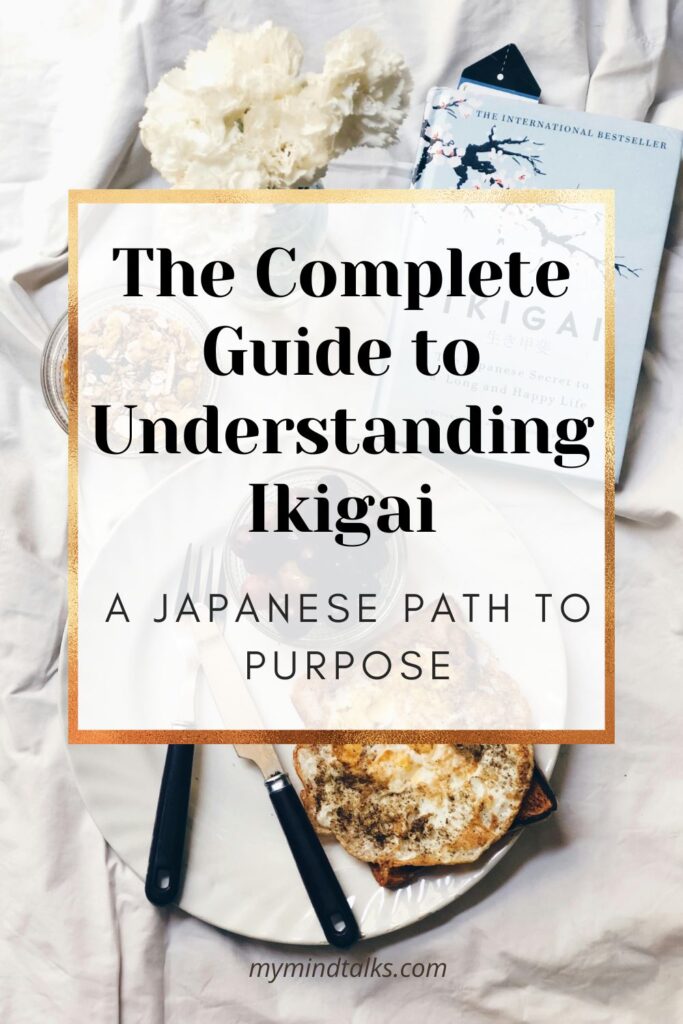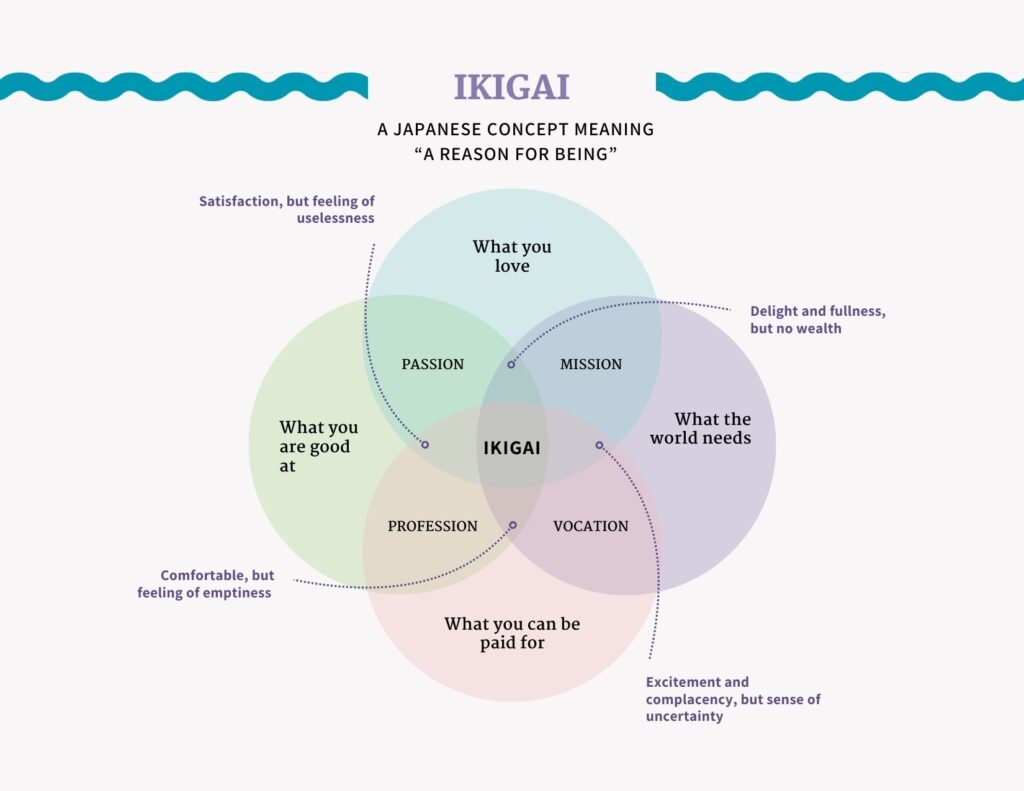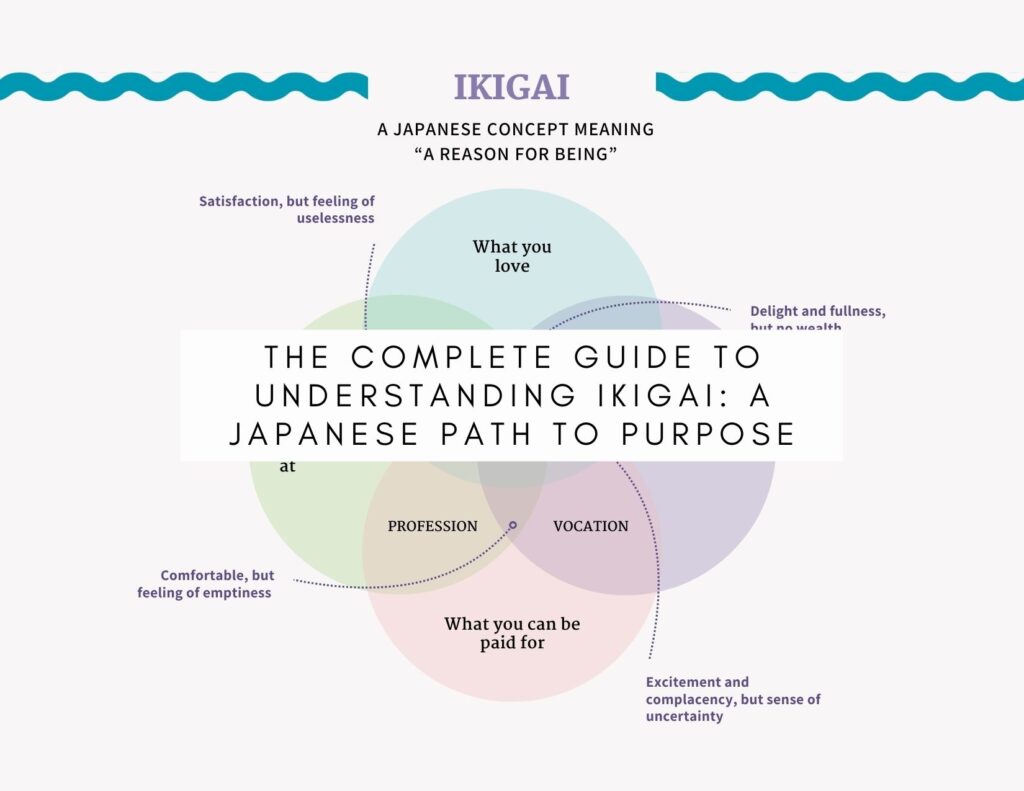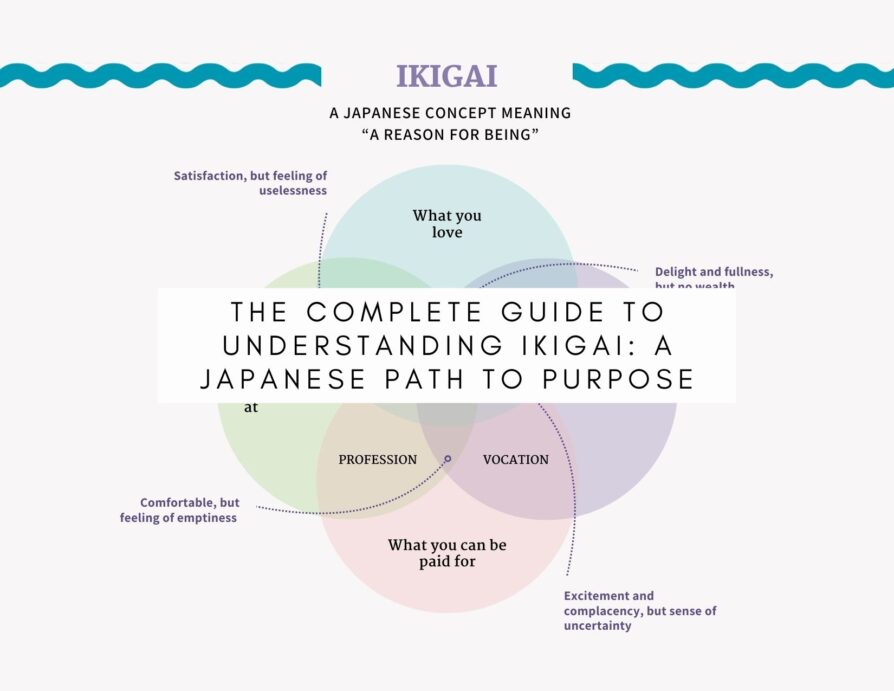In a world that often feels like it’s moving at lightning speed, many of us find ourselves asking the same question: “What’s my purpose?” This search for meaning isn’t new, but there’s a Japanese concept that offers a refreshingly practical approach to finding your reason for being. It’s called Ikigai (pronounced ee-key-guy), and it might just be the framework you’ve been looking for.
I remember when I encountered the concept of Ikigai for the first time, I was amazed by how simple yet powerful the concept was and it actually changed how I approached every aspect of my life.
Today, I want to share this powerful concept with you, breaking down its components and showing you how it can transform your approach to life, work, and personal fulfillment. Whether you’re feeling stuck in your career, searching for more meaning in your daily routine, or simply curious about different cultural perspectives on purpose, this guide will walk you through the complete journey of understanding and applying Ikigai.

What is the Meaning of Ikigai?
At its core, Ikigai translates to “a reason for being” or “a reason to get up in the morning.” The word itself combines “iki” (life) and “gai” (value or worth), creating a concept that encompasses much more than just career satisfaction or happiness—it’s about finding joy in purpose and meaning in everyday living.
Unlike Western concepts that often separate work and personal fulfillment, Ikigai integrates all aspects of life into a cohesive whole. It’s not just about finding a job you love or pursuing your passions on weekends; it’s about creating a life where purpose flows through everything you do.
As one Japanese proverb states: “Only staying active will make you want to live a hundred years.” This active engagement with life—this Ikigai—is seen as essential not just for happiness but for longevity itself.
The Four Components of Ikigai
The beauty of Ikigai lies in its simple yet profound framework, often visualized as four overlapping circles:
- What you love
- What you’re good at
- What the world needs
- What you can be paid for
The sweet spot where all four elements overlap is your Ikigai—your ideal balance of passion, mission, profession, and vocation.

Let’s break down each component:
What You Love
This circle represents activities that bring you joy, things you’d happily do even if you weren’t paid. It could be writing, cooking, solving complex problems, helping others, or building things with your hands.
Ask yourself: What activities make me lose track of time? What would I do even if nobody paid me?
What You’re Good At
Natural talents, skills you’ve developed over time, and knowledge you’ve acquired all fall into this category. These are things others recognize you for and abilities that set you apart.
Ask yourself: What skills come naturally to me? What do people often compliment me on or come to me for help with?
What the World Needs
This component connects your individual purpose to the broader community. It’s about identifying problems you care about solving or contributions that make life better for others.
Ask yourself: What changes would I like to see in the world? What problems am I drawn to solving?
What You Can Be Paid For
The practical element of Ikigai acknowledges that we need to sustain ourselves financially. This circle represents skills, services, or products that people value enough to pay for.
Ask yourself: What services incorporating my skills do people need? How can my passions and abilities create value in the marketplace?
When these four elements align, you’ve found your Ikigai—a sweet spot where passion, mission, vocation, and profession converge to create a fulfilling life purpose.
How Is Ikigai Different from Western Concepts of Purpose?
While the search for purpose is universal, there are some key differences between Ikigai and typical Western approaches to finding meaning:
| Ikigai | Western Purpose Concepts |
|---|---|
| Holistic integration of work and personal life | Often separates career goals from “finding yourself” |
| Focus on community contribution | Emphasis on individual achievement and success |
| Values balance and sustainability | Can prioritize passion at the expense of practicality |
| Sees purpose in small daily actions | Often focuses on grand life mission or calling |
| Process-oriented | Results-oriented |
The Western approach often asks, “What do you want to accomplish?” while Ikigai asks, “What brings you joy while contributing to others?” This subtle shift makes Ikigai both more accessible and sustainable as a life philosophy.
The Origin of the Ikigai Concept
Ikigai’s roots trace back to Okinawa, Japan—home to some of the world’s longest-living people. In this Blue Zone region, Ikigai isn’t just a self-help concept but a way of life that has been practiced for generations.
Traditional Okinawan culture doesn’t separate retirement from active life. Elders continue contributing to their communities well into their 90s and beyond, maintaining gardens, sharing wisdom, caring for grandchildren, or practicing traditional crafts. This continuous engagement—having a reason to get up each morning—is considered essential for both physical and mental well-being.
While the four-circle Venn diagram popularized in Western self-help literature is a modern interpretation, the underlying philosophy of finding purpose through balanced living has been central to Japanese culture for centuries.
Finding Your Ikigai: A Practical Approach
Discovering your Ikigai isn’t about having a sudden epiphany—it’s a gradual process of exploration, reflection, and experimentation. Here’s a step-by-step approach to begin your journey:
Step 1: Self-Reflection and Inventory
Start by creating four separate lists:
- Activities you love doing
- Skills you excel at
- Needs you see in the world
- Ways you could potentially earn income
Be thorough and honest with yourself. Include everything that comes to mind without judging or filtering.
Step 2: Look for Patterns and Connections
Review your lists and highlight items that appear in multiple categories. Pay special attention to anything that shows up across three or four lists—these might be clues pointing toward your Ikigai.
Step 3: Experiment and Iterate
Rather than trying to figure everything out at once, choose one or two potential paths to explore further. This could mean:
- Taking a class to develop a skill further
- Volunteering in a field that interests you
- Starting a small side project
- Talking to people who are doing work that combines elements from your lists
The key is to treat this as an experiment—gather data through real-world experience rather than endless contemplation.
Step 4: Incorporate Ikigai into Daily Life
You don’t need to quit your job or make dramatic life changes to begin practicing Ikigai. Start by infusing more purpose into your existing routine:
- Identify one aspect of your current work that aligns with what you love or what the world needs
- Dedicate time each week to activities that energize you
- Look for ways to use your skills to help others, even in small ways
- Practice mindfulness to become more aware of activities that truly engage you

Remember that Ikigai isn’t necessarily a single job or activity—it can be a tapestry of different elements in your life that together create meaning and joy.
Can Ikigai Change Over Time?
One of the most beautiful aspects of Ikigai is that it’s not static—it evolves as you grow and as circumstances change. What brought you fulfillment in your 20s may shift as you enter different life stages or as the world’s needs transform.
In Japanese culture, this fluidity is expected and embraced. Rather than finding your “one true purpose” once and for all, Ikigai invites ongoing curiosity and adaptation.
Some life transitions that might prompt a shift in your Ikigai include:
- Career advancement or change
- Becoming a parent
- Empty nest phase
- Retirement
- Health changes
- Moving to a new community
- Developing new skills or interests
Instead of seeing these transitions as disruptive, view them as opportunities to reassess and realign the four elements of your Ikigai. The framework remains constant, but how it manifests in your life will naturally evolve.
Ikigai and Career Planning
While Ikigai encompasses more than just your profession, it offers valuable guidance for career decisions. Traditional career planning often focuses primarily on skills and market demand, with passion as a “nice to have” if you’re lucky.
The Ikigai approach encourages a more holistic perspective, asking:
- How can I incorporate more of what I love into my work?
- How can I better utilize my natural strengths and developed skills?
- How does my work contribute to needs I care about addressing?
- How can I ensure my contribution is valued in the marketplace?
This doesn’t mean everyone should quit their jobs to “follow their passion.” Instead, it suggests finding ways to bring more purpose and joy into your existing work while gradually moving toward greater alignment.
For some, this might mean staying in their field but shifting to a role that better matches their strengths. For others, it could involve incorporating a meaningful side project or volunteer work that fulfills aspects their main job doesn’t cover.
Ikigai-Inspired Goal Setting
Traditional goal-setting often focuses exclusively on achievements and outcomes. Ikigai offers a more balanced approach, encouraging goals that:
- Develop skills you enjoy using
- Create value for others
- Bring joy to the process itself
- Support your practical needs
When setting goals through the Ikigai lens, consider:
- What skills do I want to develop further?
- How will this goal allow me to do more of what I love?
- Who will benefit from my achieving this goal?
- How does this goal support my material needs?
This approach creates goals that are not just achievable but deeply satisfying because they align with your intrinsic motivations rather than external expectations.
Ikigai and Work-Life Balance
In Western culture, we often talk about “work-life balance” as if work and life are opposing forces that need to be kept in check. The Ikigai perspective offers a different framing—not balance between separate domains but integration of purpose across all aspects of life.
When you’re living your Ikigai:
- Work doesn’t feel like something to escape from
- Leisure isn’t just recovery from work but meaningful in its own right
- Your energy goes toward activities that nourish rather than deplete you
- Boundaries still matter, but they’re less about separating domains and more about ensuring sustainability
This doesn’t mean working all the time or never taking breaks. Rather, it means approaching both work and leisure with intentionality, asking how each contributes to your overall sense of purpose and joy.
Read: How To Organize Your Life And Save 7 Hours Every Week
Ikigai for Entrepreneurs
Entrepreneurs face unique challenges in finding purpose and sustainability. The Ikigai framework is particularly valuable for those building their own ventures, serving as both a business planning tool and a personal compass.
When developing a business concept, consider:
- Passion: Does this business idea excite you enough to sustain your energy through inevitable challenges?
- Skill: Do you have or can you develop the capabilities needed to excel in this area?
- Need: Does your business solve a real problem people care about?
- Value: Is there a viable market willing to pay for your solution?
Many entrepreneurs focus primarily on market opportunity or their own skills while neglecting the passion aspect, leading to burnout. Others might pursue a passion without validating market need, creating unsustainable ventures. Ikigai encourages a more balanced approach from the start.
Ikigai and Mental Well-being
The connection between purpose and mental health is well-established in psychological research. Having a sense of meaning correlates strongly with greater resilience, lower rates of depression, and overall life satisfaction.
Ikigai’s holistic approach to purpose offers several mental health benefits:
- Reduced existential anxiety: The framework provides practical guidance for the often overwhelming question of “what should I do with my life?”
- Greater engagement: Focusing on activities that create flow states naturally increases present-moment awareness
- Community connection: The emphasis on contribution creates meaningful social bonds
- Sustainable motivation: Integrating passion with practical considerations prevents the burnout often associated with pursuing purpose
I’ve noticed in my own life that days filled with Ikigai-aligned activities leave me feeling energized rather than depleted, even when I’ve been working hard. It’s not about avoiding effort but ensuring that effort is directed toward meaningful ends.
Implementing Ikigai Principles in Daily Life
Finding your Ikigai isn’t a one-time exercise but a daily practice. Here are practical ways to incorporate these principles into your everyday routine:
Morning Reflection
Begin each day by asking:
- What am I looking forward to today?
- How will I use my skills to contribute?
- What small actions would bring me joy?
This simple practice orients your mind toward purpose before the day’s demands take over.
Mindful Awareness
Throughout the day, notice when you feel most engaged and energized. These moments of flow are valuable clues about your Ikigai. Similarly, pay attention to when you feel drained or disengaged, as these signal misalignment.
Evening Review
End your day by reflecting:
- When did I feel most alive today?
- How did I contribute to others?
- What did I learn or improve?
This creates awareness of patterns and reinforces your commitment to living with purpose.
Weekly Planning with Ikigai in Mind
When planning your week, ensure you schedule time for:
- Skill development in areas you enjoy
- Contributing to others in meaningful ways
- Activities that bring you genuine joy
- Work that supports your practical needs
Even small blocks of time dedicated to Ikigai-aligned activities can significantly impact your overall sense of fulfillment.
Ikigai in Retirement Planning
Western retirement often focuses on financial planning while neglecting the equally important questions of purpose and meaning in later life. The Ikigai perspective offers a more holistic approach to this transition.
In Japan, particularly Okinawa, the concept of retirement as a complete end of productive activity doesn’t exist in the same way. Instead, people continue contributing to their communities and pursuing purpose throughout their lives, simply adapting activities to match their changing capabilities.
When planning for retirement through the Ikigai lens, consider:
- Which skills and experiences do you want to continue using?
- What contributions would feel meaningful in this life stage?
- How can you structure your time to include regular doses of joy?
- What practical arrangements will support your well-being?
This approach transforms retirement from an ending to a transition—an opportunity to realign your Ikigai with your new life circumstances.
Cultural Aspects of Ikigai
While the Ikigai concept has gained popularity worldwide, understanding its cultural context adds depth to its application. Japanese culture emphasizes several values that complement the Ikigai philosophy:
- Kodawari: Commitment to mastery and attention to detail
- Omotenashi: Wholehearted service to others
- Mottainai: Avoiding waste and valuing resources
- Wa: Harmony with others and nature
These cultural values support a lifestyle where purpose comes not just from grand achievements but from performing everyday activities with care and awareness.
As we adopt Ikigai principles, we can honor their origins by embracing these complementary values while adapting the practices to our own cultural contexts.
Benefits of Discovering Your Ikigai
Research on Blue Zone regions like Okinawa suggests that living with purpose contributes to both longevity and quality of life. The benefits of finding your Ikigai include:
Physical Health Benefits
- Lower stress levels
- Improved immune function
- Better sleep quality
- Greater physical activity
- Potentially longer lifespan
Mental and Emotional Benefits
- Increased life satisfaction
- Greater resilience during challenges
- Reduced anxiety and depression
- Sharper cognitive function
- Stronger sense of identity
Social Benefits
- More meaningful relationships
- Stronger community connections
- Increased opportunities for collaboration
- Greater likelihood of positive impact on others
The most compelling evidence for Ikigai’s benefits comes from observing communities where this philosophy is embedded in daily life. In Okinawa, many centenarians attribute their longevity and happiness not to special diets or exercise regimens but to their continued sense of purpose and community connection.
Ikigai-Based Decision Making
Beyond its role in finding overall life purpose, Ikigai provides a valuable framework for everyday decisions. When facing choices about how to spend your time, energy, or resources, consider:
- Will this choice allow me to do more of what I love?
- Will it utilize or develop skills I value?
- Will it meet a need I care about addressing?
- Will it support my practical needs?
Choices that tick all four boxes represent strong alignment with your Ikigai. Those that meet two or three criteria might still be worthwhile but may require balancing with other activities. Decisions that meet only one or none of these criteria might need reconsideration.
This decision-making framework works for both major life choices (like career changes) and smaller daily decisions (like how to spend a free evening), helping you gradually align more of your life with your sense of purpose.
Conclusion: Your Personal Ikigai Journey
Finding your Ikigai isn’t a destination but a journey—one that unfolds day by day through reflection, experimentation, and mindful living. The most beautiful aspect of this philosophy is that it doesn’t require dramatic life changes or perfect circumstances to begin. You can start exactly where you are, with small shifts in attention and intention.
I encourage you to begin with simple questions:
- What activities make you lose track of time?
- What skills do you enjoy using?
- What needs do you feel drawn to address?
- How might these elements come together in practical ways?
Let these questions guide your exploration, and be patient with the process. Your Ikigai may reveal itself gradually, through seemingly unrelated experiences that eventually form a meaningful pattern.
Remember that purpose isn’t something you discover once and for all—it’s something you practice daily, adjusting and refining as you grow. The joy is in the journey itself, in living each day with intention and awareness.
I’d love to hear about your own experiences with Ikigai. What aspects of this philosophy resonate most with you? How have you incorporated purpose into your daily life? Share your thoughts in the comments below or reach out directly—your story might inspire others on their own path to purpose.
The book: Ikigai: The Japanese Secret to a Long and Happy Life
Read more:
An Introduction To Positive Psychology: Embracing The Science Of Happiness
10 Tips For Creating A Productive Workspace At Home
How To Manage Your Time Like A Pro With 9 Easy Questions
12 Good Spending Habits That Will Save You Money


